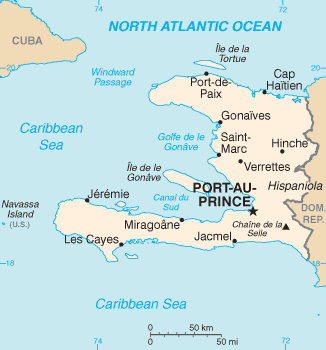Located in the heart of the Caribbean, Haiti boasts a rich cultural heritage, stunning landscapes and a complex history that has shaped its identity. While the country has faced many challenges, its map tells a story of resilience, natural beauty and vibrant communities. From mountainous terrain to coastal plains, Haiti's geography deeply influences its people, economy, and culture.
Geographical features: Haiti map
The map of Haiti reveals a variety of geographic features that contribute to its unique character. In the western part of the country lies the Massif de la Hotte, a rugged mountain range characterized by steep slopes and lush vegetation. The region is home to some of Haiti's most biodiverse ecosystems, including the Pic Macaya National Park, which harbors endemic species found nowhere else on Earth.
To the north lies the Massif du Nord, another mountain range that stretches across the country, offering breathtaking views and challenging terrain. These mountains not only provide a stunning backdrop, but also serve as an important water source for Haiti's rivers and streams, which irrigate the fertile valleys below.
The central plain, known as the Plaine du Cul-de-Sac, stretches between two mountain ranges and surrounds the capital, Port-au-Prince. The region is home to most of Haiti's agricultural land, where farmers grow crops such as rice, sugarcane and bananas to sustain local communities and contribute to the country's economy.
Coastal Beauty:
Haiti's coastline is a treasure trove of natural beauty, with sandy beaches, turquoise waters and coral reefs teeming with marine life. On the southern coast lies the picturesque town of Jacmel, famous for its vibrant arts scene and colonial architecture. Further west, Ile-et-Vache offers a tranquil retreat for visitors looking for sun, sand and peace.
In the north, the Cap-Haïtien region boasts pristine beaches and historic sites, including the grand Citadelle Laferrière and the ruins of the Sans-Souci Palace, both designated as World Heritage Sites by UNESCO. These architectural wonders stand as a testament to Haiti's rich history and the resilience of its people in the face of adversity.
Challenges and Opportunities:
Despite its natural beauty and cultural wealth, Haiti faces many challenges, including poverty, political instability, and environmental degradation. In particular, deforestation has had a devastating impact on the country's landscape, contributing to soil erosion, loss of biodiversity, and vulnerability to natural disasters such as storms and floods.
However, amidst these challenges also lie opportunities for sustainable development and conservation efforts. Organizations and initiatives are working to promote reforestation, improve infrastructure, and empower local communities to build a more resilient future. By harnessing the power of innovation, education and collaboration, Haiti can realize its full potential and build a brighter tomorrow for generations to come.
The map of Haiti offers a glimpse of the soul of a nation defined by its resilience, diversity, and natural beauty. From the towering peaks of its mountain ranges to the tranquil shores of its coastline, Haiti's geography shapes its identity and inspires admiration in visitors from around the world. As Haiti continues its journey toward progress and prosperity, let us celebrate its rich tapestry of culture, history and landscape, and strive to protect and preserve this priceless heritage for future generations.
Here are some interesting facts about Haiti:
- First independent Caribbean nation: Haiti is the first independent nation in Latin America and the Caribbean, gaining independence from France on January 1, 1804, after a successful slave rebellion led by Toussaint Louverture and Jean-Jacques Dessalines.
- Shared Islands: The island of Hispaniola, where Haiti is located, is shared with the Dominican Republic. Both countries have the same landmass but their cultures, languages and political systems are different.
- Language: Haitian Creole and French are the official languages of Haiti. While French is used in government, media, and education, Haitian Creole is spoken by the majority of the population as their primary language.
- Cultural Heritage: Haiti has a rich cultural heritage, with a mix of African, indigenous Taino, and European influences. Its vibrant arts scene includes music, dance, literature and visual arts, including unique forms such as voodoo ceremonies, Haitian folk music (compas) and lively carnival celebrations.
- Deforestation Challenges: Haiti faces significant environmental challenges, including deforestation. Over the years, the country has experienced widespread deforestation due to factors such as unsustainable agricultural practices, charcoal production, and natural disasters. This has increased vulnerability to soil erosion, loss of biodiversity and natural disasters such as storms.
- Natural Disasters: Haiti is prone to natural disasters, including hurricanes, earthquakes, and floods. The country's vulnerability to such disasters is increased due to its environmental degradation, poverty and inadequate infrastructure.
- Poverty: Haiti is one of the poorest countries in the Western Hemisphere, with a large percentage of the population living below the poverty line. Economic challenges, political instability, and natural disasters have contributed to widespread poverty and limited access to basic services such as health care, education, and clean water.
- Historic Sites: Haiti is home to several historic sites, including the Citadelle Laferrière and the Sans-Souci Palace. Built in the early 19th century, these architectural wonders are located near the city of Cap-Haitien and are designated a UNESCO World Heritage Site.
- Religion: Voodoo, a syncretic religion blending African animism with elements of Catholicism, is practiced by a significant portion of Haiti's population. Despite misconceptions, Voodoo plays a central role in Haitian culture and spirituality, influencing rituals, music, and folklore.
- Resilience: Despite its challenges, Haiti is a nation known for its resilience and the strength of its people. From its revolutionary history to its cultural contributions, Haiti continues to inspire admiration and hope for a better future.

Comments
Post a Comment